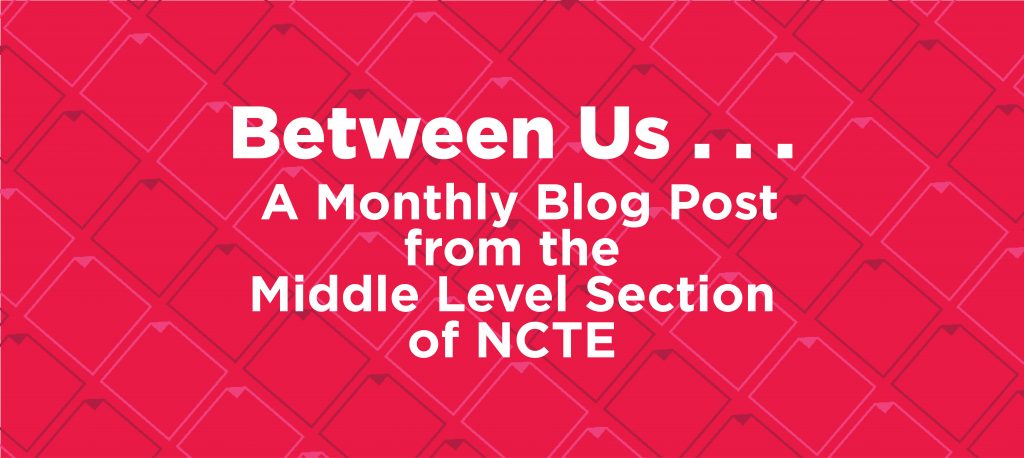From the NCTE Middle Level Section Steering Committee
This post was written by NCTE member Brooke Eisenbach, a member of the NCTE Middle Level Section Steering Committee.
Like so many middle level educators out there, my formal education and training prepared me for classroom instruction with attention to three primary areas of focus: my chosen content area, knowledge of educational theory and research, and tools for effective curriculum development and pedagogy.
Did I know the basics of grammar, composition and literary analysis? Sure! Could I cite primary educational learning theories? You bet! Was I capable of writing a five-page lesson plan with detailed means of differentiation? Absolutely. However, what I quickly discovered as I stepped into my role as an English language arts (ELA) classroom teacher and began to build connections with my students was a real need for a knowledge-base in adolescent social-emotional development. Despite years of preparation, I did not possess the mental health literacy necessary to navigate the reality that awaited me in the middle grades ELA classroom.
I have always believed in the power of literature to open minds, heal hearts, and promote human connection, empathy and understanding of the world. My classroom library shelves were filled with contemporary young adult (YA) novels that featured an array of characters, contexts and lived experiences. And, while my ultimate goal in introducing diverse books to the classroom was one of enhancing student awareness, knowledge, and critical engagement with the world, I couldn’t ignore the fact that readers would, at times, encounter stories that resonated on such a deep and personal level that they would pose questions and seek out guidance that I was ill-equipped, or too ill-informed to provide.
Specifically, I noticed that a lot of the YA titles my students found to be particularly engaging and meaningful were those that contained characters with a variety of mental health needs. And why wouldn’t they? Research shows us that there is a significant likelihood that adolescents will either experience mental distress or will know someone who experiences a mental illness.
Recent statistics reveal that 20 to 22 percent of adolescents in the US live with a mental health condition, and that about half of all mental health conditions begin in childhood or young adolescence (Daniszewski et al., 2013; Kirby & Keon, 2006).
In addition, young adolescence is a critical time in which students begin to initiate help-seeking behaviors (Chandra & Minkovitz, 2007; Lindsey & Kalafat, 1998). For this reason, it seems significant that middle level teachers consider how they might encourage readers’ mental health literacy growth while giving attention to their own mental health literacy and considerations of the literature they elect to highlight and use within the classroom.
As a teacher educator, I often find myself reflecting on my initial years in the ELA classroom and will draw upon these experiences to consider questions I wish I had known to ask as I sought to meet the academic, social, and emotional needs of learners in the classroom. In considering the inclusion of mental-health themed YA literature in the classroom, specifically at a time when each day seems to bring a new, unforeseen challenge, or globalized trauma to our world, there are a few guiding questions that I ask my preservice teachers to consider as they prepare for their future as middle level ELA teachers:
What do you believe and know about mental health?
Reflecting on our own beliefs on mental health and mental health supports, as well as considering what we know, believe we know, and have yet to learn is crucial to our role as ELA teachers engaging in the teaching of mental-health themed literature. It’s important to be honest in understanding ourselves, our own experiences with mental health, and what we have yet to learn before we move forward in bringing this literature and discussion into the classroom space.
Upon reflection, we may come to realize that we are lacking crucial or accurate knowledge of mental health and mental health supports, thereby putting ourselves at risk of holding very stigmatized perceptions of mental health conditions. Therefore, the first step is taking time to ask questions, seek out resources, and learn more to further our own mental health literacy development.
How are you navigating book selection?
It’s important to be aware of your process in identifying and selecting books for whole-class, small-group, and independent reading opportunities. Consider asking yourself: Am I striving to avoid toxic tropes and stereotypes within the literature I choose to introduce to readers? Am I seeking out titles that offer hope and a positive exploration of mental health services? Am I identifying literature that features multi-faceted characters and storylines? Take time to do the research, read the books, and consider your goals for student reading and your own literature-based instruction. While authors should never be required to self-disclose their own struggles with mental health, a growing population of YA authors are opting to share their experiences in an attempt to normalize the conversation around mental health and mental health support. Authors often want to help readers see that they are not alone in their mental health concerns or needs.
In searching for titles that reflect an accurate representation of mental health needs and supports, it can be helpful to identify and include a wide variety of voices in your classroom library and curriculum. Just remember that one individual or character’s experience with mental health does not speak for a generalized population. Consider selecting a range of titles that reflect a diverse array of experiences, intersections of identity, and encounters with mental health.
What is it you know, or don’t know, about your current classroom and community context?
Our students should remain the top priority in all curricular and instructional decision making. For this reason, it is important to keep in mind what we know of our students, their families, their communities, and their daily contexts as we navigate book selection and implementation in our classrooms. While we like to think a commitment to community and connection means we know our students, the truth is no student should feel it necessary to self-disclose their personal experiences, trauma, or mental health needs. As a result, there are always going to be factors in a student’s life and personal history that extend beyond our threshold of knowledge. It’s important to accept this reality and consider this truth as we navigate book selection and our approach to the teaching of this mental-health themed literature.
How will you integrate this book into your curriculum?
Once you consider your students and potential titles, consider the purpose and goals of your lesson. How might you effectively incorporate the selected title(s) into your curricular objectives? Our approach to a whole-class novel study will vary from our planning of small group or independent book study. We can use what we know of our students, families, community and context, along with our considerations for text selection to guide the direction of our lesson preparation. We can also plan for collaborations with the school’s mental health support team to provide additional information and resources that extend beyond our realm of ELA expertise.
For example, might the mental health themes in the text call for preparatory lessons that provide background understanding of particular mental health conditions? In seeking to expand our students’ mental health literacy, we might find it essential to dispel myths, provide greater context and introduce foundational knowledge before diving into the storyline. What of the unique needs of our readers? We must consider that some scenes and character experiences within the text could serve as potential triggers for some readers. This should factor into our approach to reading and conversing on a selected text, thereby promoting greater consideration for student choice in book selection and continuation.
It’s okay to walk away from a book. We can make space in our curricular planning to prepare alternative texts and opportunities for learners who find a need to transition titles. And, we must be cognizant of what our instructional decisions and assignments ask of our readers. While we can expect that some students will form personal connections as they engage with the story, we must be careful to avoid assignments or prompts that require students to self-disclose.
Who can you refer to for additional support?
Finally, as educators with limited or scant training in mental health, we need to identify avenues for support. We should seek out resources that can enhance our own mental health literacy: books, articles, professional development opportunities, and experts in the field of mental health. In addition, we should have a range of resources and supports available for our students as they navigate their own learning and engagement with the literature. We can identify our school’s mental health support team, invite them to be a part of our planning and instructional implementation, and ensure students know who to seek out should they find themselves in need of some form of mental health support. It’s also a great idea to have community resources available and accessible for students at all times.
As a novice ELA teacher, there was so much I needed to know and understand in my attempts to effectively integrate mental-health themed literature into the middle level classroom. In reflecting on my tenure in middle level teaching, I remain hopeful that the questions and key considerations that surface now will aid my preservice teachers in their own preparation for bringing this vital literature into their curriculum and classroom space and into the hands of their adolescent readers.
 Brooke Eisenbach is an associate professor of middle and secondary education at Lesley University in Cambridge, MA and a former middle level English Language Arts teacher. Her work and teaching focus on middle level education with specific attention to middle grades virtual education and enhancing students’ mental health literacy through adolescent literature. She is proud to serve on the Middle Level Section Steering Committee.
Brooke Eisenbach is an associate professor of middle and secondary education at Lesley University in Cambridge, MA and a former middle level English Language Arts teacher. Her work and teaching focus on middle level education with specific attention to middle grades virtual education and enhancing students’ mental health literacy through adolescent literature. She is proud to serve on the Middle Level Section Steering Committee.
It is the policy of NCTE in all publications, including the Literacy & NCTE blog, to provide a forum for the open discussion of ideas concerning the content and the teaching of English and the language arts. Publicity accorded to any particular point of view does not imply endorsement by the Executive Committee, the Board of Directors, the staff, or the membership at large, except in announcements of policy, where such endorsement is clearly specified.

